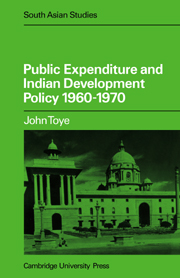Book contents
- Frontmatter
- Contents
- List of Tables
- Preface
- List of Abbreviations
- Introduction
- PART ONE GENERAL
- PART TWO EMPIRICAL EVIDENCE
- 4 The fiscal performance of the public sector
- 5 Public expenditure and the industrial recession
- 6 The degree of public expenditure centralization
- 7 The growth of state governments' spending
- 8 Public investment, public saving and the state governments
- PART THREE CONCLUSIONS
- APPENDICES
- List of works cited
- Index
4 - The fiscal performance of the public sector
from PART TWO - EMPIRICAL EVIDENCE
Published online by Cambridge University Press: 09 January 2010
- Frontmatter
- Contents
- List of Tables
- Preface
- List of Abbreviations
- Introduction
- PART ONE GENERAL
- PART TWO EMPIRICAL EVIDENCE
- 4 The fiscal performance of the public sector
- 5 Public expenditure and the industrial recession
- 6 The degree of public expenditure centralization
- 7 The growth of state governments' spending
- 8 Public investment, public saving and the state governments
- PART THREE CONCLUSIONS
- APPENDICES
- List of works cited
- Index
Summary
The Third Plan noted that ‘careful attention must be given to factors which will increase the capacity of the public sector to expand still more rapidly … As the relative share of the public sector increases, its role in economic growth will become even more strategic and the state will be in a still stronger position to determine the character and functioning of the economy as a whole.’ The public sector was seen as ‘producing large surpluses for development’, and therefore being ‘one of the most important factors determining the rate at which the economy can grow’. This was a more positive and confident statement of the state accumulation policy than those in either the First or the Second Plan. The First Plan had only said that ‘in promoting capital formation on the required scale … the state will have to play a crucial role. This need not involve complete nationalization of the means of production … [but it] does, however, mean a progressive widening of the public sector and a re-orientation of the private sector to the needs of a planned economy’. The public sector, according to the Second Plan, had ‘not only to initiate developments which the private sector is either unwilling or unable to undertake; it has to play the dominant role in shaping the entire pattern of investments in the economy’.
- Type
- Chapter
- Information
- Public Expenditure and Indian Development Policy 1960–70 , pp. 85 - 118Publisher: Cambridge University PressPrint publication year: 1981



